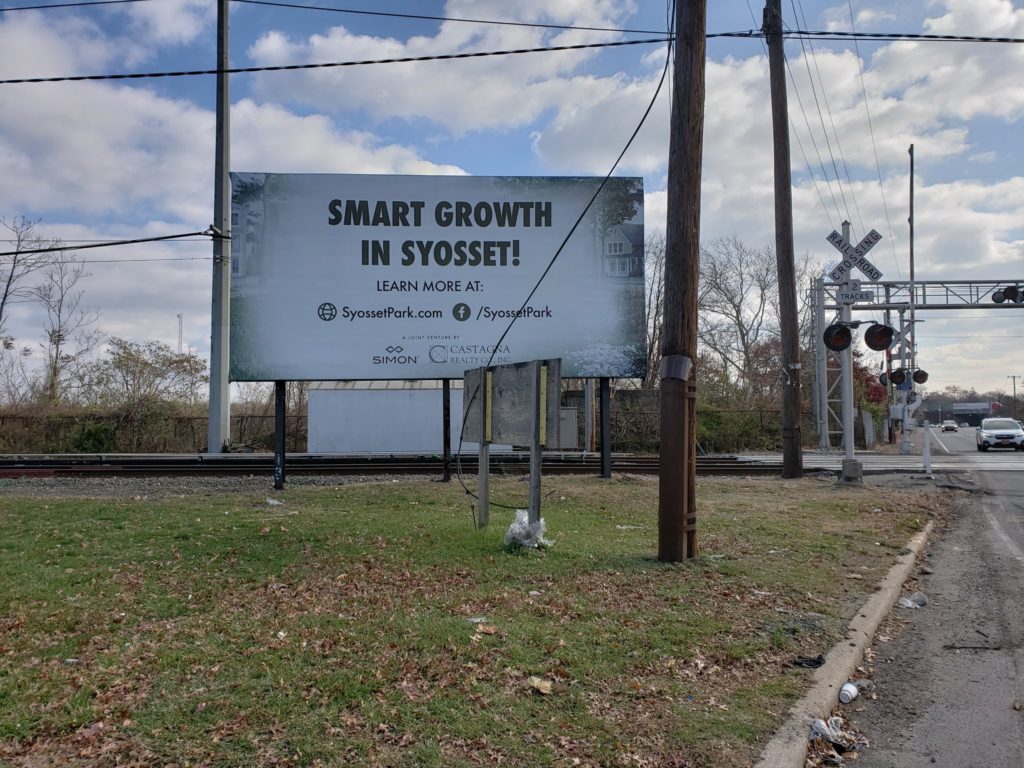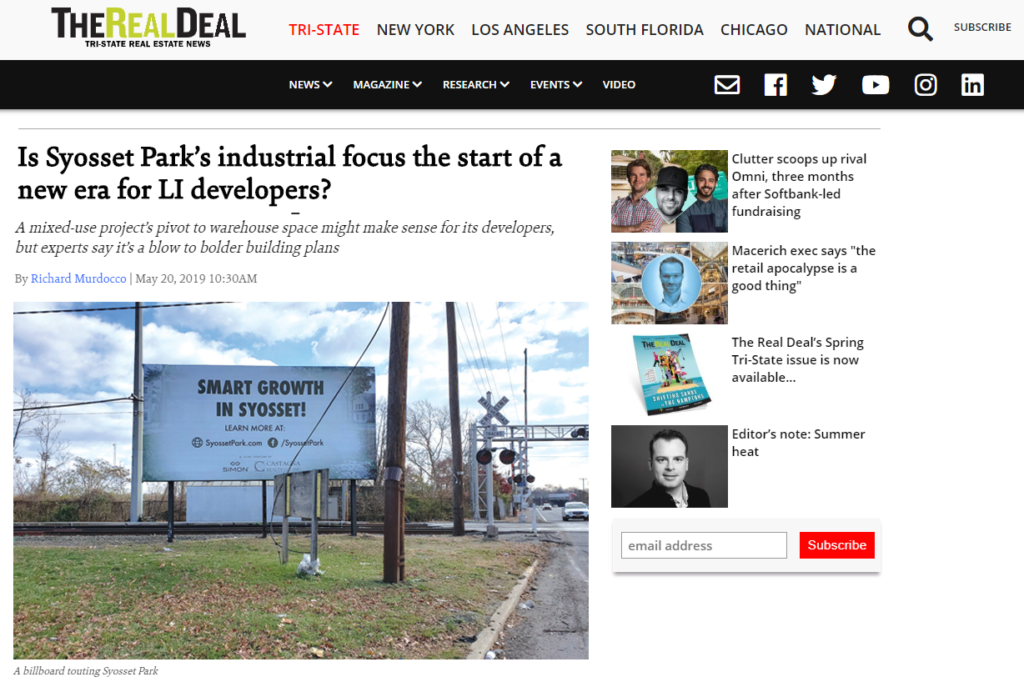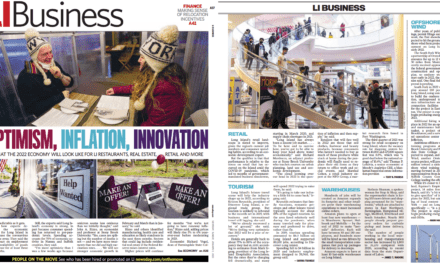The following is an extended version of a story that was first published in The Real Deal’s June 2019 Tri-State Magazine. You can read the original version here.
A mixed-use project’s pivot to warehouse space might make sense for its developers, but experts say it’s a blow to bolder building plans.
By Richard Murdocco
Pictured: A billboard advertising Syosset Park near the former Cerro Wire site.
One of the most ambitious real estate projects in Nassau County’s history is now headed back to the drawing board after developers faced a prolonged battle with both Syosset residents and a local school district.
First pitched to the Town of Oyster Bay in 2015, Syosset Park is a mixed-use proposal for nearly 93 acres in the heart of the county created by Manhasset-based developer Castagna Realty and Simon Property Group, the country’s largest mall operator.
The concept crafted by the co-developers — two hotels totaling 350 rooms, 625 housing units, 200,000 square feet of office space and 464,000 square feet of entertainment and retail space — would have been adjacent to a capped landfill pitched to become a public park near a former federally-designated Superfund site.
Though touted by its backers as a transformative vision for Nassau’s last large swath of vacant space, the plan instead resulted in a groundswell of community opposition over the site’s environmental conditions and the impact of the proposed development on local schools. What was once billed as a mixed-use developer’s dream, the project could be poised to adopt a more industrial approach — is what happened with Syosset Park a potential sign of things to come for Long Island developers?
Syosset Park Development LLC, the joint venture formed by Castagna and Simon Property that spent $32.5 million in 2013 to acquire 54 acres in Syosset, indicated earlier this year that while it had not completely abandoned its plans for the site, it would pursue an as-of-right industrial option in line with its current zoning.
With consumers increasingly expecting on-demand shipping thanks to near-instantaneous delivery from services like Amazon Prime, the need for warehouse space has grown exponentially nationwide. Factoring in increased land values in formerly industrial areas of New York City, the suburban communities of Long Island have transformed into a prime industrial market in recent years.
Experts in the region told The Real Deal that while the change makes business sense — such a plan would minimize resident and municipal involvement, as well as capitalize on the superheated market for warehouse space in the greater Tri-State area — the shift from mixed-use to industrial amounts to a lost opportunity for Nassau.
And at least one notable supporter of the former Syosset Park plan believes that Oyster Bay officials are partially to blame for its shift in strategy.
“It’s zoned as industrial warehouse space, and unless the town is planning to provide [more] leadership, which would be refreshing, those are their options,” said former Suffolk County Executive Patrick Halpin, who served as a consultant to Syosset Park’s developers from the time of its proposal in 2015 until last year.
Halpin, a managing director at Mercury Public Affairs, noted that he was expressing his own personal views, not those of someone formally affiliated with the project. But he pulled no punches in his assessment of why Syosset Park is now changing course.
“In order to do something that is dramatic, but also consistent with the character of Long Island, you need to have a town that is willing to spearhead that type of development,” Halpin said.
Halpin pointed to the Village of Patchogue — often held as the regional standard for major redevelopment plans — as an example. A study released in December by the Long Island Regional Planning Council found that Patchogue’s revitalization had generated $693 million in economic growth between 2000 and 2017, numbers that included private construction investment, downtown business operations and non-local household spending, according to Newsday.
“So far, the Town of Oyster Bay hasn’t demonstrated that commitment,” Halpin said.
An Adaptive Space
In March, Oyster Bay officials told Long Island Business News that they couldn’t comment on any changes to the Syosset Park project since they haven’t met with the developers since last December.
The relationship between Oyster Bay officials and Syosset Park’s developers seems to have soured. At press time, Castagna and Simon had reportedly moved to end a sale agreement with the town for land adjacent to the Long Island Expressway in a dispute over fees. Such squabbling has made the already complex effort to build Syosset Park more difficult. Oyster Bay, which has not met with the developers since December, said it’s up to Simon and Castagna on how to proceed.
“The developer… has not yet resubmitted plans for the property,” Oyster Bay spokesperson Brian Nevin told TRD. “The town awaits their new vision for the property.”
For Simon, an Indianapolis-based real estate investment trust that posted $1.1 billion in higher than expected first quarter earnings despite a spate of nationwide retail store closings, market forces have the company remaining adaptive in order to turn a profit for shareholders.
In a February earnings call, Simon CEO David Simon expressed concern about a bevy of retail bankruptcies across the country, but highlighted the REIT’s profitability as a sign of strong demand for alternative retail space. “I think we’ve never been busier on the alternative areas,” said Simon, adding that the future of malls can be found within the “live, work, play” concept often tied to mixed-use space.
But while Simon’s “live, work, play” pitch might be working in some suburban parts of the country, Long Island’s robust industrial market may just be hotter, said several industry sources.
“Industrial is the hottest product type on the Island,” David Pennetta, executive director at Cushman & Wakefield’s Long Island office, said. “There’s been pressure from companies located in Brooklyn and Queens being bought out for residential developments that is now taking up part of the supply.”
Pennetta noted how office, retail, and medical uses were also taking well-located industrial properties and converting them away, stressing that according to his recollection, no industrial has been built in the past 15 years across the region.
Together, these factors amounted to big changes in the island’s regional market, including how, exactly, metrics on industrial rents are measured. “Rents were $8.50 gross per square foot,” he said. “Now, they are easily $10, $12, or $15 per square foot not including taxes. We’ve pretty much doubled rent, which is fostering new construction.”
Syosset Park’s new direction can be seen as an effort to capitalize on those changing market dynamics.
“The industrial sector on Long Island has been very strong,” said Mitchell Pally, chief executive officer of the Long Island Builders Institute. “Their feeling is they can build this and people will use it, so why not.”
Pally told TRD that it was unfortunate that the site can’t be “transformational” for Long Island. “Obviously, it’s disappointing they seem to be moving away from a transformational project to a strictly one-purpose project,” he said, noting that he understands why the builders are making the shift, especially given both community objections and the municipality’s relative inaction.
To Pally, the shift is the result of a builder pursuing the path of least resistance in an unwelcoming political environment. “They may have decided to cut their losses, do what they can do as of right and move on.”
Halpin, who remains a supporter of Syosset Park’s initial mixed-use plan, estimated that the parcel’s current zoning allows for a warehouse of up to 800,000 square feet. To commercial real estate experts, a pivot to industrial is good for the bottom line.
“Experienced developers like Simon and Castagna know the risks of proposing a project like Syosset Park on Long Island,” Kyle Strober, executive director of the Association for a Better Long Island, a real estate lobbying group, told TRD in a statement. “Elsewhere, their commitment to a transformative development would have been strongly supported by the surrounding community and government officials. While it would have had a positive impact on the town’s economy and its image, they now have the ability to pivot to industrial which, in today’s market, can be as financially viable as their initial plan.”
“It’s definitely a hot market right now thanks to a complete lack of supply and very high demand [for last-mile warehouse space],” said David Hercman, director of asset management for Syosset-based industrial landlord Milvado Property Group. Hercman noted that Syosset Park’s proximity to the Long Island Expressway makes it a particularly valuable industrial parcel. “It would be a strategic industrial location that is advantageous for anybody,” he said.
Pennetta agrees. “It’s going to be an attractive project, because most of the buildings here are from the Grumman era,” Pennetta said, citing the close column spacing and low ceiling heights found within older buildings across Nassau and Suffolk counties relative to today’s design standards. “Since it fronts on the most heavily trafficked commercial route on the island, it is a great site for an industrial location. They’ll find success with whatever they do.”
Industrial Roots
Fortuitously enough, while Syosset Park may seem like a graveyard for many developers mired in controversy, it’s also a former industrial site that has sat vacant for roughly 30 years.
Nearly 40 acres of the property was once home to a plant for the Cerro Wire and Cable Corporation, which manufactured and improperly disposed of copper rods and cables for decades. After the plant closed in 1986, the Tribune Company bought the property three years later with the intention of building a printing plant for the New York Daily News. But that project never got off the ground and Tribune turned over control of the parcel to Taubman Centers, a suburban Detroit-based shopping center REIT.
Taubman, new to the Long Island mall market, proposed building a luxury retail complex with 1 million square feet, only to face the same entrenched community opposition that Simon would subsequently run into. Ironically enough, Simon backed the initial backlash in order to stifle competition with its own local marquee malls, such as Roosevelt Field in Garden City and the Walt Whitman Shops in Huntington. Taubman finally gave up the fight and sold its stake in the former Cerro Wire site and another Arizona mall to Simon as part of a $230 million deal in January 2014.
By that time, Simon had already paid $32.5 million to Oyster Bay to acquire an adjacent property that had been home to the town’s public works department. That created the present day Syosset Park: nearly 93 acres of land assembled by Simon despite the fact that the local community seems adamantly opposed to another shopping mall development.
Dr. Lee Koppelman, a former regional planner for Nassau and Suffolk counties who now serves as head of the Center for Regional Policy Studies at Stony Brook University, has long studied the various proposals for Syosset Park. He said that while the site is big enough for a shopping mall like the one proposed by Taubman, Long Island already has an ample amount of retail space.
Industrial space that is clean and creates jobs could be a economic boon to Nassau, said Koppelman, but its builders must strike a careful balance.
“If you’re talking about mixed-use with industrial, the problem comes about where trucks are in relation to residential,” Koppelman said. “That’s one of the problems with mixed-use. It can be done, but it has to be done astutely. There is usually a big swallow between what is good planning and what the developers propose.”
For builders, the fiscal clock continues to tick as a new project takes shape.
“You can only hold on to a property for so long,” Pennetta said. “Taubman held it for 20 years, and Simon/Castagna has had it for five years already. All that time you have to carry it, pay taxes, the cost of capital, and all that.”
“As a developer, you have to at some point move forward,” said Milvado’s Hercman, calling the most recent as-of-right industrial proposal a win for Syosset residents. He noted that when Syosset Park in its current form was first proposed in 2015, Long Island’s industrial landscape was much different than it is today.
Even amid the continued pushback against Syosset Park and ongoing delays faced by the project, Hercman expects its developers to see significant returns on their collective investment if they seek to capitalize on an underutilized industrial asset. After years of inaction, he said, something should eventually be built on the site.
“With the costs of construction compared to [industrial] rents, it just didn’t make sense [three years ago],” Hercman said. “Now with the as-of-right zoning, it has finally come to the point that industrial use is being justified by the rents.”
Accepting opposition?
Those living within Oyster Bay, of which Syosset is a hamlet, have historically not embraced the mixed-use proposals that have risen elsewhere on Long Island. As such, local elected officials have strived to maintain the status quo valued by their constituents.
The looming question over Syosset Park is whether other developers with stalled projects on Long Island will follow its lead and scale back their original plans. Despite significant pushback on similar projects elsewhere in the region, one prominent builder refuses to change course.
“Not as long as I’m alive,” said veteran developer Jerry Wolkoff, whose $4 billion mixed-use Heartland Town Square project on 452 acres in Brentwood has run into a variety of development delays over the past 15 years. (Wolkoff sued Suffolk County in February over a sewer connection holding up the project, which is expected to include 9,000 residential units, 3.4 million square feet of office space and 1 million square feet of retail.)
Wolkoff, citing his own completed industrial projects, said that such properties are increasingly becoming important for Long Island due to zoning changes in the once predominantly industrial Queens neighborhoods of Long Island City and Maspeth.
“It would be a big plus to get as much industrial as we can [to Long Island],” said Wolkoff, noting that Nassau needs to compete with areas like Jersey City for such facilities.
But when asked about his ambitious mixed-use Heartland endeavor, Wolkoff admitted that he’s thinking beyond the tides of the industrial market.
“For us in Suffolk, our young people and empty nesters need apartments,” Wolkoff said. “We don’t have anything like Heartland Town Square.”
Even some Long Island industrial stalwarts are preparing for potential makeovers that could include residential space. A report released in late April and commissioned by the Suffolk County Industrial Development Agency recommended that the Hauppauge Industrial Park add residential units and co-working spaces to better position itself as a regional economic hub.
“I’m a big believer in smart-growth redevelopment,” said Halpin, the former Suffolk County executive. “[Syosset Park] would have been a major revitalization of an old industrial area.”
By forgoing townhouses and condominiums in favor of warehouses and loading bays, Halpin believes that Syosset Park’s backers will have sacrificed what could have been a grander vision for development in the region.
“As a Long Islander, this is a tragedy,” he said. “In the end, it’s the Town of Oyster Bay that will decide what to do. If they chose to not make a decision on this latest proposal of the site, that’s still technically a decision.”
Editor’s Note, 5/20/19: After this story went to press, Syosset Park’s developers reportedly canceled their deal with Oyster Bay and sought the return of their initial $30 million investment.
















Halpin is foolish to compare the needs of a higher end residential community like Syosset to blighted Brentwood. Syosset Park was never planned as a 55+ empty nester community, but a burden on a very heavily taxed school district that would have required a major investment to support almost 700 condos.
I’m sure we will have many projects shot down as “mixed use” development is only over developing Long Island. We have overcrowded transportation facilities and limited water resources.
The days of post war Levitown’s are gone. Who would want to move into a 9000 unit development. A traffic nightmare with the same jammed I-495, parkways and overcrowed LIRR.